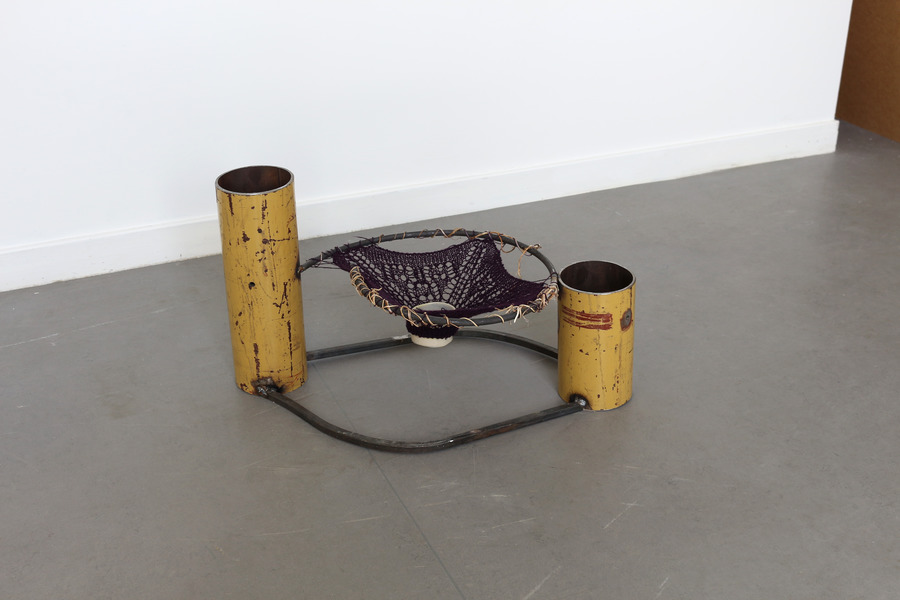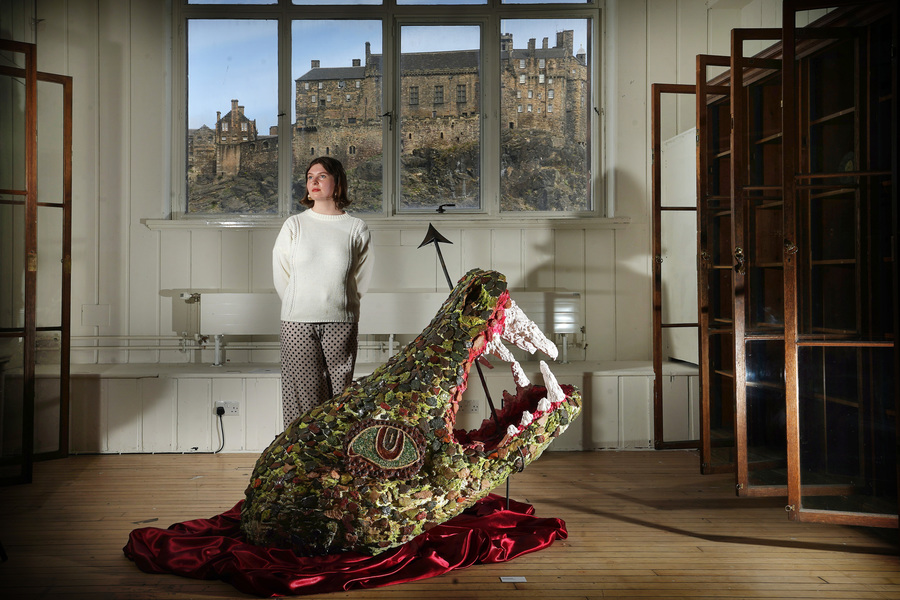ECA Degree Show 2025: The Review
Emerging artists at the Edinburgh College of Art find inspiration in mythology, the natural world and the domestic sphere
Set against the striking backdrop of a window looking onto Edinburgh Castle, a large dragon’s head, rendered in all its bloody-mouthed glory according to the visual language of Medieval tapestries, lays with an arrow pierced through its mouth. This grisly sculpture belongs to An Aftermath, A Crime Scene, a multi-part installation by Libby Entwistle based on the life of Saint Margaret. According to legend, the saint killed a dragon that was sent to torture her by a spurned Roman general. Glazed clay slabs around the room, featuring disembodied hands and red, frightened faces, serve as mute witnesses. The abuse of and ensuing resistance by women across history forms the crux of Entwistle’s installation, which seeks to interrogate "monstrosity and the fluid thresholds between victimhood and agency". Themes of folklore and femininity are echoed in the dreamy works of Abigail Miskin, whose intricate etchings of sprites and fairies are inspired by her childhood in Yorkshire and her research into the post-WWI fairy fever phenomenon. Alluding to themes of domesticity, several of Miskin’s pieces are framed delicately in crochet, adding to their sense of storybook tenderness.
After examining Scottish fungi under a microscope, Jewellery and Silversmithing graduate Isabel Honey Coles recreated their complex patterns on Britannia 958 silver using ancient granulation techniques. Suspended on moss-green threads, the pendants are luminous and richly textured, like small, elegant moons. Meanwhile, Carmen Rachel Alexander’s Friday Street tells a playful story of memory and landscape. The artist presents a box of trinkets including film, vintage postcards, old matchboxes (one proudly advertising, in Gothic font, ‘The Bahamas Most Distinguished Tavern!’) and more, many of which were sourced from weekly visits to a Suffolk car boot sale. The curios are presented alongside metallic cylinders, the same size as film canisters, on which the artist has delicately etched the impression of trees. Humorous and tender, Friday Street explores "sentimental landscapes that aim to blur the line between reality and memory".
With icy precision, Marni Saunders’ eerie, orderly sculptures scalpel open the trappings of domestic life. Plain kitchen sponges and cutlery sit half-submerged in transparent glass panels mounted on the wall, a cross between laboratory kitchen sinks and petri dishes. On one coffee mug, a kiss mark suggests human presence – perhaps a stolen hint of something unruly – but the objects are suspended from time, as gelid as the motionless soap suds on their glass containers. Another work titled LOAD features two wall-mounted washing machine drums stuffed with white linen. With their shiny inner shells laid bare, the washing machines appear retro-futuristic, unsettling in their perfect, industrial geometries. Taking daily objects and rendering them strange, Saunders’s works illuminate the discomfiting tensions between "mess and disorder, discomfort and care, shame and beauty".
Another artist who plays with polarities is Lucie Benninghaus, whose sculptures combine steel mesh with colourful yarn that grows moss-like from the metal structures. One piece is a steel cube composed in neat, expanding lines. Orange yarn twines on one side, wobbly as a child’s drawing. Another sculpture features two worn-out metal tubes, their yellow paint fading; between them is a near-circle created by a narrow, curving metal pipe. Together they resemble a crude scale-model of some abandoned industrial plant – but a net of purple yarn blooms right in the middle, unexpected and tender. Influenced by environmental fragility, Benninghaus’s juxtaposition of the industrial and the homely explores concepts of "destruction, decay and ephemerality".
In the Fashion graduate showcase, we find the colourful works of Olivia Musson. Inspired by the hanging gardens of Babylon, Musson’s gowns are composed of exuberant, sun-ripened florals. The designer’s extravagant use of colours, textures, and silhouettes reveals a Rococo fondness for flair and excess, but at their core, these designs are distinctly contemporary, countering the pastel-pastoral with vibrant colours and glossy bows, everything oversized and over-glamorous. These are gowns of summertime triumph. In her artist’s statement, Musson writes: "If, at this moment, I cannot have a physical garden, I shall create one that can be worn."
The overall mood of the show is playful and introspective, with many pieces drawing visual or thematic inspiration from mythology, natural landscapes, and daily life. It seems to me that a collective sense of world-making runs throughout the show. Both in terms of reenvisioning the past and creating better futures, the works speak of optimism, of brighter seasons ahead.
The ECA Degree Show runs until 6 Jun
Finf the online showcase at graduateshow.eca.ed.ac.uk


